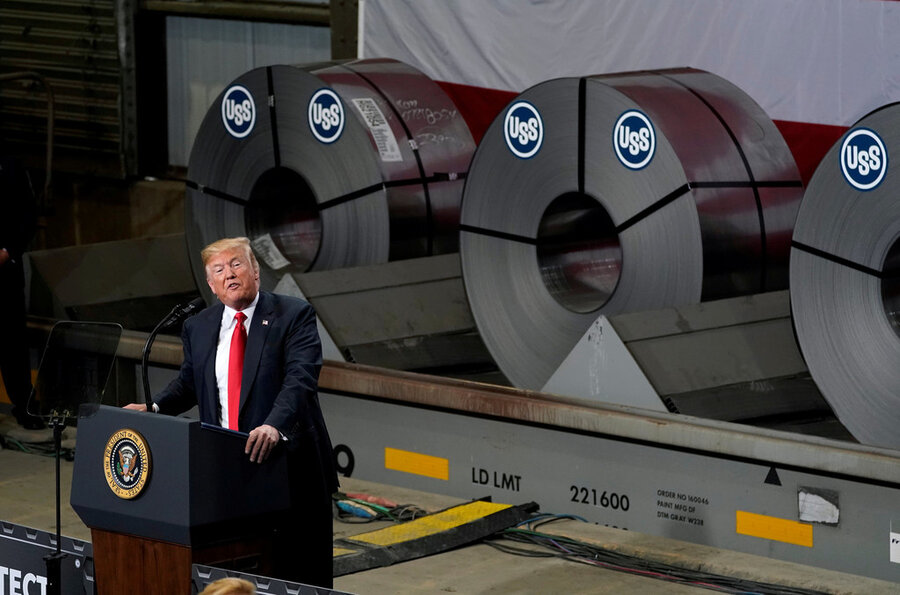Trump enlarges his vision on trade
Loading...
After starting trade skirmishes with America’s closest economic partners, the Trump administration may be moving toward resolutions that could bring substantial benefits – and not only on trade itself.
The latest shift was President Trump’s July 25 agreement to negotiate key trade and economic issues with the European Union. The two sides also called a temporary halt to imposing further tariffs while the talks move forward. Significantly, Mr. Trump said both sides of the Atlantic could win in this “new phase” of the relationship. This is a notable improvement in tone from his recent reference to the EU as a principal “foe.”
A substantive agreement is far from assured. European Commission President Jean-Claude Juncker still needs all 26 EU member states to agree to the talks. Nevertheless, the new perspective is that both parties can emerge winners. This is significant because the trans-Atlantic economy is the world’s largest. Trade and investment between the EU and the United States employs about 9 million workers and supports as many as 15 million jobs.
On the other big trade front – renegotiating the North American Free Trade Agreement – Trump spoke positively with Mexican President-elect Andrés Manuel López Obrador (aka AMLO) after his July 1 election victory about reaching an agreement on updating NAFTA. The two men followed up with a positive exchange of letters, in which Trump wrote that a successful renegotiation of NAFTA “will lead to even more jobs and higher wages for hard-working American and Mexican workers.”
Although Trump added a threat that the negotiation should go quickly or he would “go a much different route,” he and AMLO avoided clashes over hot-button issues related to immigration, and supported a rapid return to negotiations. US Trade Representative Robert Lighthizer subsequently told Congress he hopes to complete the basic NAFTA negotiations in August. Mexican and Canadian trade ministers have echoed that goal.
As with the EU, the stakes for North America are high: $1.2 trillion in current trade and as many as 14 million US jobs (as well as millions more in Mexico and Canada, America’s largest export destinations).
The reasons for the shifts in tone are widely debated. Some experts ask if the US change in tone is sincere or just tactical. Others surmise that the forceful concerns of US farmers, businesses, and legislators about the combined harmful effects of so many conflicts with trading partners had an impact on the White House. The president and his supporters argue that his tough approach has led America’s partners to come up with attractive offers for the US.
Worth underscoring is that a key change in the US perspective appears to be a desire to facilitate solutions for all. Many observers have lamented that a big obstacle has been a US attitude that trade conflict must be “win-lose,” with the US as the clear winner.
This shift to a climate of give-and-take allows all sides to fix problems and open up market opportunities for workers, farmers, businesses, and consumers. Rather than fight over a bigger piece of the current economic pie, the parties can grow the pie. That approach helps build political support for an agreement at home – although each country must also assist industries and workers in adjusting to heightened competition.
The NAFTA talks will be the first test for this new perspective. All sides agree the treaty needs an update after 25 years. Much technical work is needed to fix the 30-odd chapters of the treaty, which alone will bring challenging issues. On the political level, a handful of proposals raised by the US are being resisted by Mexico and Canada. These include rules for making vehicles, provisions to settle disputes, and the issue of whether to include a five-year “sunset clause” in which all three countries must agree to continue the treaty. Canada and Mexico, as well as many people in the US, say the uncertainty of such a sunset clause would undermine long-term investments.
As it tries to reshape global norms to ensure commerce keeps expanding, the US needs all the allies it can get. This makes it important to adopt a perspective that allows trade “wins” for all.
Progress in trade negotiations has long rested on the knowledge that economies will make progress if they include more players rather than exclude them.





